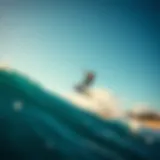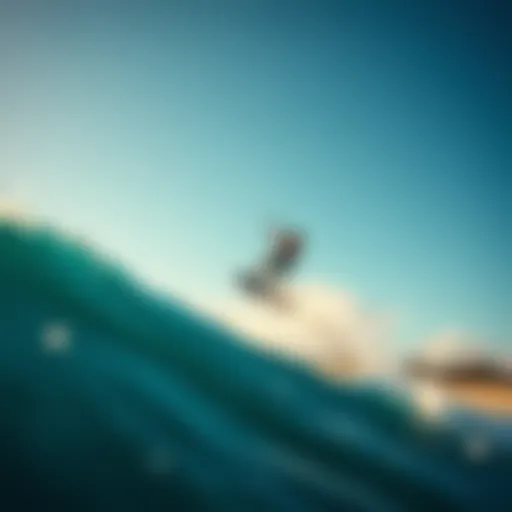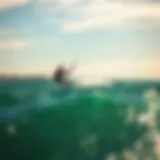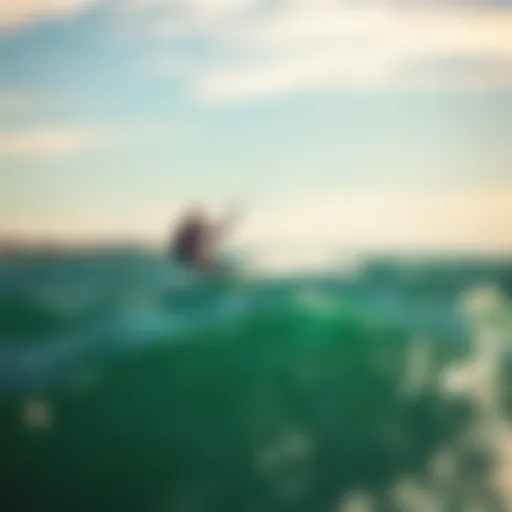Essential Gear for Kitesurfing: A Detailed Exploration
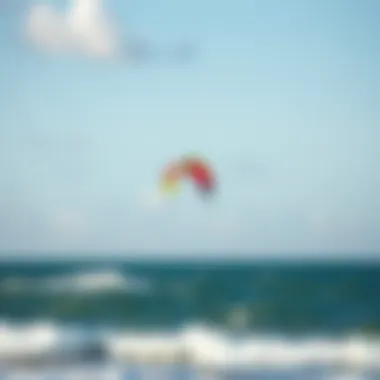
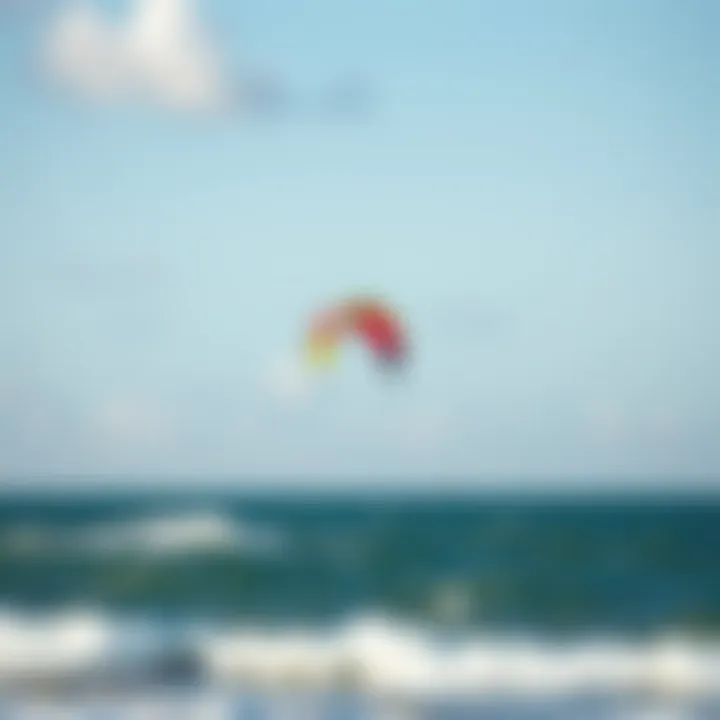
Intro
Kitesurfing combines the thrill of surfing with the art of flying a kite, creating a sport that pulls at the heartstrings of adventure-seekers around the globe. It’s not just about riding the waves; it’s about harnessing the wind, reading the water, and mastering every gust that swirls around you. But before you can carve out a path in the ocean, you must understand the essential equipment that turns an aspiring kitesurfer into a skilled practitioner.
In this exploration, we delve deep into the various components that make kitesurfing not only possible but also enjoyable and safe. From the kite that catches the breeze to the board that skims over the surf, and the harness that keeps everything tied together, each piece plays a crucial role in the overall kitesurfing experience. Whether you’re just starting out or looking to sharpen your skills, knowing the gear inside out is key.
Techniques for Kiteboarding Enthusiasts
Mastering kitesurfing is more than just having the right gear; it’s about employing techniques that elevate your experience from basic to exhilarating. Let’s break this down for both beginners and advanced riders.
Beginner Techniques
If you’re new to kitesurfing, it can feel like you’re juggling a hundred things at once. Here’s a roadmap to get you started:
- Water Start: Learning to pop up on the board while managing the kite can be frustrating. Focus on positioning the kite correctly and using your feet to gain stability.
- Kite Control: Spend time practicing with the kite on land. Understanding how it handles in the wind will make your water starts much smoother.
- Falling Safely: Let’s face it, you will fall. Practicing how to depower your kite and rolling away from the kite when you crash can save you from minor injuries.
Advanced Maneuvers
Once you get the hang of the basics, it’s time to spice things up. Advanced techniques can make kitesurfing feel like a dance on water:
- Jumping: Timing is everything. Master the art of edging against the board while pulling upwards on the kite to gain altitude and finesse your landing.
- Transitions: Learning how to switch from heel to toe side smoothly not only looks impressive but also helps maintain speed and control.
- Tricks: As you gain confidence, experimenting with tricks like the back roll or railey will challenge your skills and thrill your audience.
"The beauty of kitesurfing is that every wave and every gust offers a new opportunity to improve. There’s always something to learn."
Equipment Reviews
To truly get the most out of your kitesurfing adventures, understanding your gear options is essential. Let’s dive into the nitty-gritty of kites and boards.
Kite Reviews
When it comes to kites, you’ll find various designs tailored to different styles and wind conditions. Here’s a glance at popular options:
- C-Kites: Known for their stability and power, great for jumping.
- Bow Kites: Offer improved safety and a larger wind range, perfect for beginners.
- Hybrid Kites: Combine features of both C and Bow kites, making them versatile for various riding styles.
Each type of kite serves a different purpose. When selecting your kite, consider your skill level, typical wind conditions, and what kind of kiting you wish to pursue.
Board Reviews
Your board choice can make or break your experience. Here’s what to consider:
- Twin-Tip Boards: Excellent for beginners and perform well in various conditions.
- Directional Boards: These mimic surfboards and are suited for more advanced riders looking to ride waves.
- Freestyle Boards: Lightweight and designed for tricks, they are tailored for confident riders pushing the limits.
In reviewing these boards, look for factors like construction material, rocker design, and foot strap comfort to make the best choice for your riding style.
For those keen on diving deeper into the nuances of kites and boards, consider visiting resources such as Wikipedia, or forums on Reddit to see discussions and reviews from the kitesurfing community.
With this information in hand, you’re now better equipped to not only select the right gear but also to improve your kitesurfing techniques. Whether you float on the surface or soar through the air, understanding your equipment and the fundamental techniques is vital for any kiteboarder.
Prelude to Kitesurfing Gear
Kitesurfing is a thrilling blend of wind, water, and skill, demanding not just enthusiasm but also the right equipment. Understanding kitesurfing gear is essential for anyone looking to navigate the waves and harness the wind effectively. This introductory section serves to illuminate the myriad components involved in kitesurfing, emphasizing why each piece of gear holds significance in enhancing your experience.
What Constitutes Kitesurfing Gear
When we talk about kitesurfing gear, we refer to a collection of essential items that ensure both performance and safety on the water. This includes:
- Kites: The heart of the sport, these are available in various types such as foil kites, LEIs, and hybrids.
- Boards: Comprising twintip and directional boards, the choice directly influences your riding experience.
- Harnesses: Used to secure yourself to the kite, they come in different forms, each suited for specific riding styles.
- Safety equipment: This is not just a recommendation but a necessity. Impact vests, helmets, and leashes should never be overlooked.
- Wetsuits: Depending on the climate, they protect against cold water, ensuring comfort during prolonged sessions.
These components serve distinct purposes but work in unison to create a cohesive kitesurfing experience. Each element can significantly affect your ride, handling, and overall enjoyment. Selecting equipment that suits your style and the conditions is paramount to mastering this exhilarating sport.
Importance of Choosing the Right Equipment
Choosing the right kitesurfing gear is akin to laying a solid foundation before building a house; it determines how well you can adapt to the elements and improve your skills. The wrong equipment can lead to frustrating experiences, decreased safety, and even injuries. Here are a few key considerations:
- Skill Level: Beginners should focus on forgiving equipment that allows for easy learning curves, while seasoned riders may opt for high-performance gear tailored to specific conditions.
- Conditions: Wind speed, water type, and personal preferences greatly influence gear choice. For example, lighter winds generally call for larger kites, while strong winds are better handled with smaller options.
- Fit and Comfort: Whether it’s a harness or a wetsuit, ensuring that your gear fits well avoids discomfort during rides, which is essential for longer sessions.
"Choosing your kitesurfing gear isn't just about preference; it's about enhancing your safety and performance on the water."
In summary, the right selection of kitesurfing gear forms the backbone of any successful outing on the waves. Investing time and thought into what you choose can make all the difference in not just skill advancement but also in safety.
For more comprehensive insights, exploring resources like Wikipedia on Kitesurfing or visiting forums such as Reddit's Kitesurfing Community can provide valuable information.
Types of Kites
Understanding the types of kites is central to getting the most out of your kitesurfing experience. Each kite configuration offers unique handling characteristics, performance attributes, and ideal conditions for riding. The choice of kite can greatly impact your skills, comfort on the water, and overall enjoyment. In this section, we’ll break down the three primary types of kites commonly used by kitesurfers and the significant factors to consider when choosing one.
Foil Kites
Foil kites are constructed with internal cells that capture air, creating lift. They are typically lightweight and can be utilized in low wind conditions, making them favorable for beginner and intermediate riders. The design incorporates fewer struts, which contributes to their compact size when deflated, allowing for easier transport and storage.
One notable advantage of foil kites is their efficiency; they can provide a smooth ride even with minimal wind. However, they require a different flying technique compared to inflatable kites, which may take some getting used to. It's essential to practice and become comfortable with these kites, especially since they respond to movements quickly.
Key points about foil kites:
- Hybrid designs available that merge characteristics of both foil and LEI kites.
- Ideal for those who favor light wind riding and precise control.
"Foil kites can give you a different flavor of kitesurfing, particularly if you enjoy those light wind days that others might shy away from."
LEI (Leading Edge Inflatable) Kites
LEI kites, or Leading Edge Inflatable kites, are the backbone of modern kitesurfing. Their design features inflatable struts along the leading edge, providing stability and shape retention while in the air. These kites are renowned for their versatility, accommodating riders of all skill levels, from beginners to seasoned pros.
The ability to relaunch easily from the water is one of the LEI kite's standout features. When it tumbles, a simple pull on the control lines can set it back into the wind, making it an excellent choice for learners still mastering their skills. Additionally, these kites perform well across various wind conditions and can deliver powerful boosts, making them a favorite among freestylers and wave riders.
When selecting an LEI kite, consider factors such as the relative size and aspect ratio, as these will influence the handling and performance attributes of the kite. A kite with a higher aspect ratio typically flies faster and is more efficient, while a more rounded shape enhances stability and low-end power.
Characteristics of LEI kites:
- Durable and resistant to wear and tear, suitable for diverse conditions.
- Comes in various sizes tailored for specific wind conditions and rider preferences.
Hybrid Kites
Hybrid kites blend the best elements of foil kites and LEI kites. They are designed to offer the efficiency of a foil with the ease of use and relaunch capabilities of an inflatable. This type has gained popularity among kitesurfers seeking a well-rounded option that performs in a wide range of conditions.
Hybrids typically feature a partially inflated leading edge while maintaining the cell structure of a foil, leading to a kite that is lightweight yet reasonably stable and easy to control. They are often favored by advanced riders who demand versatility without sacrificing performance.
When selecting a hybrid kite, it’s still crucial to consider your conditions and riding style. Autonomy in tailoring the kite setup according to wind conditions and personal preference can be a game-changer in terms of performance. Therefore, understanding how each of these elements affects your ride is critical.
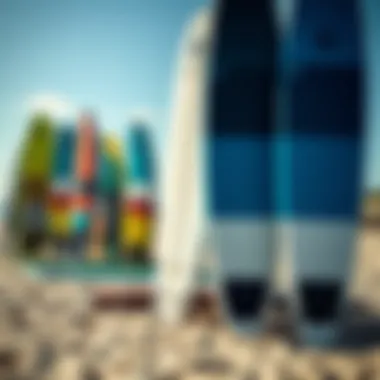

Noteworthy benefits of hybrid kites:
- Excellent for a variety of disciplines, including freestyle, wave riding, and light wind conditions.
- Offers a unique flying experience that caters to varying skill levels.
Selecting the Right Kite Size
Selecting the right kite size can make or break your kitesurfing experience. It’s not just a matter of preference; the size of your kite directly affects performance, handling, and safety on the water. A well-matched kite size for the current conditions allows riders to harness the wind effectively, resulting in smoother rides and better control. Conversely, using a kite that’s either too big or too small can lead to undesirable outcomes, such as oversteering, stalling, or even accidents. Therefore, understanding the nuances of kite sizing is fundamentally important for anyone looking to engage in kitesurfing.
Factors Influencing Kite Size
When it comes to picking the right kite size, several vital factors come into play:
- Wind Strength: This is the most critical aspect to consider. Wind conditions can vary significantly throughout the day, and the size of your kite should align with these shifts. Lighter winds typically necessitate larger kites, while gusty or strong winds require smaller kites.
- Rider Weight: Heavier riders tend to need larger kites to generate enough lift. A person weighing 200 pounds might require a kite size that differs from someone who weighs 150 pounds.
- Skill Level: Novice riders usually benefit from riding larger kites because they provide more lift and stability, helping to boost confidence as they build their skills. On the other hand, seasoned kitesurfers often opt for smaller kites, as they allow for quicker turns and tricks.
- Type of Riding: The style of kitesurfing influences kite size as well. Freestyle riders might lean toward smaller kites to enhance maneuverability, while wave riders may prefer larger kites for increased power in the surf.
"Choosing the right kite size is not just about what looks good or what feels comfortable; it's about matching the kite with the conditions and your own riding profile."
Kite Size Recommendations for Conditions
Here are some general kite size recommendations based on varied wind conditions:
- Light Wind (10-15 knots):
- Moderate Wind (15-20 knots):
- Strong Wind (20-30 knots):
- Very Strong Wind (30+ knots):
- Recommended Kites: 12m - 16m for light wind performance. These larger kites can catch the gentle breeze effectively.
- Recommended Kites: 9m - 12m. This size offers a good balance between power and control, allowing for a comfortable ride.
- Recommended Kites: 6m - 9m. Here, smaller kites help prevent the rider from being overpowered by stronger wind.
- Recommended Kites: 4m - 6m. As winds ramp up beyond 30 knots, very small kites are essential for safe and effective kitesurfing.
Ultimately, the key is to familiarize yourself with your equipment and the conditions of the day, which will help you become more adept in your decision-making about kite size. Consider keeping a journal to track conditions and see how varied kite sizes affect your riding experience. This way, you're not just riding the waves; you're riding them with wisdom.
Kitesurfing Boards
Kitesurfing boards are a critical element of the overall kitesurfing experience, serving as the connection between the kiter and the water. The right board can dramatically improve performance, control, and enjoyment. Different types of boards cater to various styles, skill levels, and conditions, making selection an important aspect for any aspiring kitesurfing enthusiast. This section will explore the types of boards available, their characteristics, and crucial considerations for board sizing and shape.
Types of Boards
Understanding the differences in kitesurfing boards is foundational for selecting the appropriate gear. Specifically, two main types stand out: Twintip and Directional boards.
Twintip Boards
Twintip boards are among the most popular choices, especially for beginners and freestyle enthusiasts. A key characteristic of twintip boards is their symmetrical shape, which allows for riding in both directions without needing to switch the stance. This feature is particularly beneficial for tricks and maneuvers, as it promotes versatility.
Additionally, twintip boards often come with foot straps or bindings, offering a secure attachment to the rider. This allows for more stability during jumps and tricks, which many kiteboarders value.
However, they may not perform as well in certain conditions, such as strong winds or waves, compared to directional boards. This can be a disadvantage for advanced riders looking to master various terrains. Nonetheless, their ease of use makes them a great option for learners.
Directional Boards
On the other hand, Directional boards are designed primarily for riding with a specific front and back. They resemble surfboards more closely and are particularly well-suited for wave riding and downwind conditions. A notable characteristic of directional boards is that they typically feature a longer outline and a tapered tail, enhancing their ability to cut through waves.
This board type is favored for its performance in surfing conditions, enabling riders to carve through the water with finesse. Many advanced kitesurfers appreciate the unique responsiveness and stability directional boards provide, especially when riding in challenging wind and water conditions.
However, the need to switch stances while maneuvering can be a challenging adjustment for newcomers and may limit the tricks that can effectively be executed.
Board Size and Shape Considerations
Selecting the appropriate size and shape of a kitesurfing board is essential for maximizing performance and enhancing the overall riding experience. Factors such as rider weight, skill level, and the type of conditions you'll face all play pivotal roles in making the right choice.
- Larger Boards: Generally better for beginners and heavier riders, these boards offer more surface area, providing improved floatation and stability in the water.
- Smaller Boards: Preferable for advanced riders aiming for speed and agility, smaller boards typically allow for quicker turns and easier maneuverability.
Consider a few key points when assessing board shape:
- Rockers: A lower rocker will make the board faster, whereas a higher rocker can provide smoother landings but might be slower overall.
- Fin Configuration: Different numbers and placements of fins affect how the board tracks in water and how responsive it will be.
Choosing the right board shape and size can seem complex, but considering these elements will help a rider tailor their experience to their specific needs.
"Choosing your board might feel overwhelming, but remember, it's about finding what suits your style and the conditions you'll be riding in. Trust your instincts and don't be afraid to experiment!"
Kitesurfing boards reflect the balance between rider preference, environmental conditions, and performance goals. Embracing this diversity can help foster a deeper connection to the sport, benefiting both skill advancement and enjoyment.
Harnesses for Kitesurfing
In the world of kitesurfing, harnesses play a pivotal role that goes beyond mere utility. These essential pieces of gear are what connect the rider to the kite and, ultimately, the elements. Choosing the right harness not only affects comfort but also directly impacts performance and maneuverability on the water. As riders navigate through waves and harness the wind, understanding the different types and fits of harnesses is crucial.
Types of Harnesses
Waist Harnesses
Waist harnesses are a popular choice among many kitesurfers, particularly those who prefer a freer range of motion. Positioned around the waistline, they provide firm support while allowing the rider to bend and pivot with ease. A key characteristic of waist harnesses is their low-profile design. This allows for better body movement and a more natural stance, making them a favored option for those looking to perform tricks or aggressive maneuvers.
Benefits of Waist Harnesses:
- Flexibility: They offer great freedom of movement, enabling more dynamic riding styles.
- Less Bulk: Their streamlined form minimizes excess material, keeping the rider light on their feet.
- Comfort: When adjusted correctly, they can be very comfortable, reducing pressure points on the body.
On the flip side, their placement around the waist might not be as secure for every rider, especially in rough waters. The chance of riding them incorrectly can lead to discomfort as well. It's all about finding that right balance between your personal riding style and the design of the harness.
Seat Harnesses
Conversely, seat harnesses bring a different flavor to the table. As the name implies, these harnesses sit lower on the hips and often include leg straps, creating a seat-like effect. This design distributes the load across the thighs and hips, which can be beneficial for stability and support, particularly for beginners or those who favor a more relaxed riding style.
Benefits of Seat Harnesses:
- Stability: The seated position prevents the harness from riding up during crashes or heavy pulls.
- Supportive: They offer excellent lower back support, which can reduce fatigue on longer sessions.
- Secure Fitting: The leg straps add a layer of security, making them a popular choice for riders who may feel insecure with a waist harness.
However, the downside may lie in the loss of agility that waist harnesses offer. Riders might find they have restricted movement, particularly if they’re used to maneuvering their kite aggressively.
Choosing the Right Harness Fit
Selecting the right harness fit is essential for maximizing comfort and performance on the water. A harness that’s too loose can lead to chafing and the risk of it riding up during rides, causing distractions. On the other hand, a harness that’s overly tight can restrict breathing and movement.
When choosing a harness, consider the following factors:
- Check the sizing chart provided by the manufacturer; each brand may have different sizing regulations.
- Ensure that the harness sits comfortably on your hips or waist without pinching.
- Always try on different styles to find out which feels best during typical kitesurfing maneuvers.
Ultimately, a good harness will enhance riding enjoyment and safety. It’s crucial to spend time finding a fit that works for your unique body shape and riding style.
Safety Gear Essentials
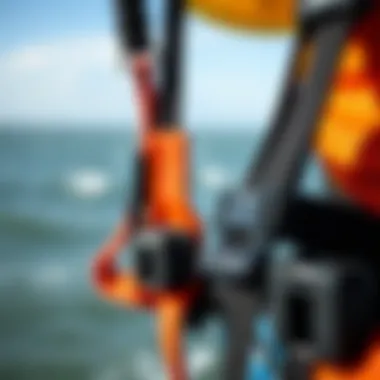
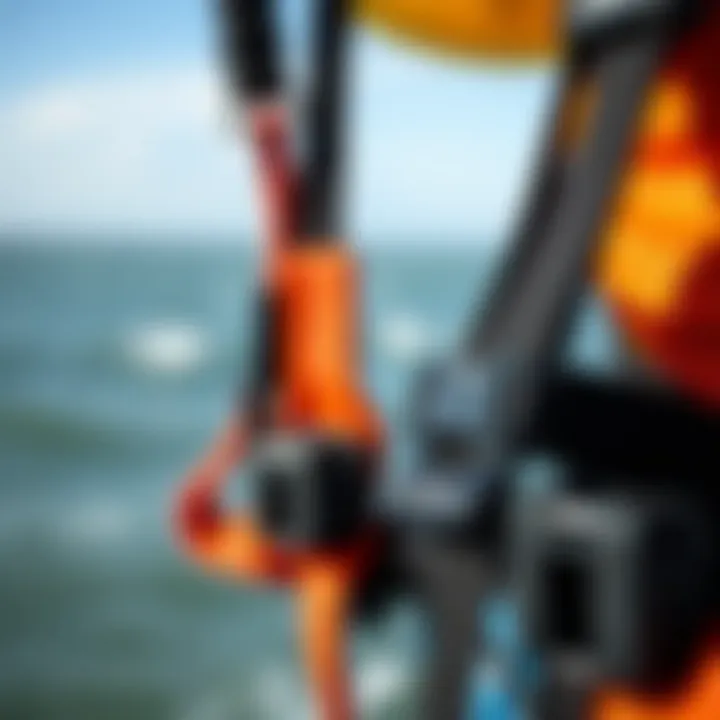
Kitesurfing, while exhilarating, carries its fair share of risks. Understanding and utilizing safety gear is vital not only for individual safety but also for enjoyment of the sport. This section encapsulates the essentials of safety gear, including impact vests, helmets, and leashes. Each piece of equipment plays a unique role in ensuring that riders can focus on the thrill of the waves without compromising their well-being.
Impact Vests
Impact vests offer crucial protection during kitesurfing. When a rider takes a tumble or becomes airborne, the risk of injury increases significantly. An impact vest, often made from buoyant material, can mitigate this risk. These vests are designed to absorb shock while still allowing for flexibility and mobility. Using a suitable impact vest can mean the difference between a bruising landing and a smooth recovery.
- Material Considerations: Look for vests made from materials like neoprene for comfort and durability.
- Fit is Key: A snug fit is essential. If the vest is too loose, it won’t provide adequate protection; too tight, and it can restrict movement.
"Every time you hit the water, it’s like crashing into concrete. A good impact vest can save your skin and keep your focus on the next ride."
Helmets
Helmets may not be the first piece of gear that comes to mind when one thinks of kitesurfing, but they serve a life-saving purpose. In the heat of navigating high winds and waves, an unexpected fall or collision can lead to serious injuries to the head. Helmets designed for water sports are usually lightweight yet strong, offering protection without sacrificing performance.
Here are some aspects to consider:
- Weight and Comfort: Opt for a helmet that feels lightweight. If it’s too heavy, it can be uncomfortable over longer sessions.
- Ventilation: A well-ventilated helmet prevents overheating. Being out on the water for hours requires maintaining a comfortable temperature.
Leashes
The leash is a simple yet indispensable part of kitesurfing safety gear. It connects the rider to the board, ensuring that in the event of a fall, the board does not drift away. This can prevent dangerous situations from arising where a loose board poses a risk to others on the water.
Here’s how to pick the right leash and why it matters:
- Choosing Length and Strength: Make sure the leash length is suitable for your riding style. A longer leash might give more freedom but can also increase the chance of tangles.
- Quality Matters: Look for a strong leash made of durable materials. It's worth investing in a reliable leash that can withstand the forces acting on it during a ride.
In summary, investing in high-quality safety gear is non-negotiable for a kitesurfer. Each component has distinct advantages and together they foster a safer and more enjoyable experience on the water. Evaluate your needs, and gear up to ride with confidence.
Wetsuits and Clothing
When it comes to kitesurfing, the weather can be unpredictable, and the water temperature can change from pleasant to frigid in the blink of an eye. This makes the importance of proper wetsuits and clothing hard to overstate. It's not just about staying warm; it's also about enhancing your performance and ensuring safety while enjoying your time on the water. The right clothing can impact your comfort and mobility, allowing you to focus on mastering your skills rather than being distracted by the elements.
Material Choices for Wetsuits
Wetsuits are typically made from neoprene, a synthetic rubber that provides thermal insulation, buoyancy, and flexibility. The particular thickness and type of neoprene matter a lot. Here are some points to consider:
- Thickness: Most wetsuits range from 2mm to 6mm in thickness. A thicker wetsuit gives more insulation but may restrict movement. For warmer waters, a 2mm-3mm suit can suffice, whereas colder climates may need 4mm-5mm.
- Lining: Look for wetsuits with thermal lining. This helps in retaining heat and can significantly improve comfort. Some suits come with plush fleece lining for added warmth.
- Seams: Stitched seams may let some water in but are more durable, while glued and blind-stitched seams offer better waterproofing but can be less robust. Choose based on durability needs and your typical conditions.
- Flexibility: A suit with a high degree of flexibility will not hinder your movements, which is crucial for kitesurfing maneuvers. Selecting a wetsuit with added panels of super stretch neoprene may be beneficial.
Choosing Appropriate Clothing for Kitesurfing
Kitesurfing demands clothing that is not just comfortable, but also practical. It’s essential to strike a balance between style, protection, and function. Here are some tips:
- Layering: Depending on the temperature, wearer’s preferences, and wind conditions, layering can be an effective choice. A thin base layer can wick away moisture, while an outer layer can provide wind protection.
- Quick-Dry Fabrics: Choose tops and bottoms made from synthetic fabrics that dry fast. This is important after a fall; you'll want to stay dry to prevent losing body heat.
- UV Protection: Spending hours under the sun means that UV protection is a must. Consider rash guards with UV protection to safeguard against harmful rays, even on cloudy days.
- Footwear: Don’t forget your feet! Neoprene booties or water shoes can provide warmth and grip while giving you a good feel of the board.
A well-thought-out clothing and wetsuit choice can elevate your experience on the water, making it more enjoyable and safe.
Finale
Every detail matters when selecting wetsuits and clothing for kitesurfing. From the material used in your wetsuit to the fabric of your tops, understanding the nuances can keep you warm, protected, and mobile. Always choose quality over quantity, and invest time in finding gear that fits both your body and kitesurfing style.
For more information on kitesurfing gear, visit Wikipedia or check out discussions on Reddit.
Remember, the right clothing and wetsuits not only help you perform better but also enhance your overall enjoyment of this exhilarating sport.
Kitesurfing Accessories
Kitesurfing is not just about the kite and board; the small details make a sizable difference in performance and safety. Kitesurfing accessories are essential for enhancing the experience on the water. They not only contribute to the overall functionality but can also be the deciding factor in enjoying a day on the waves versus having a frustrating outing. The right accessories can take your session from good to great, ensuring a well-prepared and enjoyable ride.
Pump Types
When it comes to inflating your kite, choosing the right pump can save you time and energy. There are generally two main types of pumps: single-action and double-action.
- Single-action pumps push air into the kite only on the upstroke, which means you have to make twice as many strokes to fill your kite compared to a double-action pump. This type is usually lighter and simpler, making it a decent choice for those who prioritize portability.
- Double-action pumps, on the other hand, push air on both the up and down strokes, significantly reducing the number of pumps needed. This type is particularly advantageous for larger kites. Even though it might be a bit heavier, the efficiency can save you energy in the long run.
Beyond the basic types, consider a pump with a pressure gauge. It can be a game changer, as over-inflating may lead to kite damage and under-inflating could undermine performance. A gauge will help you find the sweet spot and get it right every time.
Also, look for a pump with a sturdy hose and nozzle—after all, nothing spoils your day quite like equipment that fails when you need it the most. Consider adding a few patches and seals for quick fixes in case of emergency. Addressing these little things ahead of time can enhance your preparedness and peace of mind.
Repair Kits
Mishaps can happen even to seasoned riders. An effective repair kit is a must-have for any kitesurfer, no matter at what level they are riding. Many kits are available, but let's dive into what should truly be within yours.
First off, ensure you have some adhesive patches. These can swiftly address pinholes or small rips in your kite's fabric. They are easy to apply and often can save your kite from being left on the shore.
Additionally, spare lines are vital. Kite lines can fray over time, and a snapped line while on the water could potentially become dangerous. Having both main and safety lines ready can be a lifesaver for any kitesurfer.
Lastly, don't underestimate the need for tools like a small scissors and a screwdriver. These handy items can help you perform a quick fix on the spot, getting you back in the game with minimal downtime. With a properly stocked repair kit, you'll never have to worry too much about what might go wrong on the water.
“A well-prepared rider is a confident rider. Don't let a small issue destroy your session.”
When packing your kitesurfing accessories, ensure your pump and repair kit are easily accessible in your gear bag. Proper organization can save time and keep you focused on the ride ahead.
Maintenance Tips for Kitesurfing Gear
Taking care of your kitesurfing gear is not just about extending its life; it's about ensuring efficiency, safety, and peak performance every time you hit the water. A proactive approach to maintenance can prevent potential hazards, improve your overall experience, and ultimately save you money on replacements or repairs. To the untrained eye, gear might seem robust enough to take a beating, but neglect can lead to unseen wear and tear, transforming your equipment into a liability rather than an asset.
Kite Care Practices
Kites are the heart of your kitesurfing setup, and paying attention to their condition is essential. Here are some key points regarding good kite care:
- Rinse After Use: Saltwater and sand can wreak havoc on your kite. After each session, rinse it thoroughly with fresh water to prevent corrosion and buildup.
- Inspect Thoroughly: Before packing it away, inspect for any signs of wear, such as abrasions on the bladders or fabric. Look for leaks in the seams and ensure that all lines are free from frays. Small issues can turn into big problems if not caught early.
- Dry Properly: Make sure your kite is completely dry before storing it. Storing a wet kite can lead to mold and mildew. Lay it flat in a cool, shaded area to prevent deterioration from direct sunlight.
- Secure Storage: Invest in a quality bag for your kite. A bag will protect it from scrapes, punctures, and UV exposure.
- Be Mindful of Storage Conditions: Stash your kite in a dry, ventilated spot away from extreme heat or cold. Extreme temperatures can damage the material, impacting its longevity.
"An ounce of prevention is worth a pound of cure." Keeping your kite in good shape today saves you hassle tomorrow.
Board Maintenance
Your board is your dance partner on the water, and keeping it in shape is essential for smooth sailing. Here’s how you can maintain your board:
- Wipe Down: After each session, wipe down the board to remove any salt and sand.
- Check for Dings: Inspect the bottom for dings or scratches. Minor nicks can often be repaired with a simple epoxy resin. Extreme damage might need professional attention, so don’t hesitate to reach out if unsure.
- Fin Check: Ensure fins are in good order. Loose or damaged fins can compromise handling, making your ride unpredictable. Tightening screws regularly can save you a headache later.
- Avoid Sun Exposure: Like your kite, your board can get sunburnt, leading to fading and general wear. Keep it covered or stored away from direct sunlight when not in use.
- Clean and Store: If you know you won't be using the board for a while, consider giving it a full clean. This might involve a mild soap solution for the top surface, drying appropriately, and then storing it in a suitable environment.
With proper care, both your kite and board will remain reliable, enhancing your kitesurfing adventures. Prioritizing maintenance isn't mere upkeep; it's a commitment to enjoying the sport to its fullest.
Gear Storage Strategies
When you invest time and money into kitesurfing gear, proper storage becomes paramount. Many kitesurfers overlook this essential aspect, but how you store your equipment can greatly affect its longevity and performance. Just like you wouldn't let a fine wine sit in direct sunlight, the same principle applies to your kitesurfing gear. From protecting your kite fabric from UV rays to ensuring your board is safe from dings and scratches, getting the storage right can save you both cash and hassle down the line.
Best Practices for Storing Kites
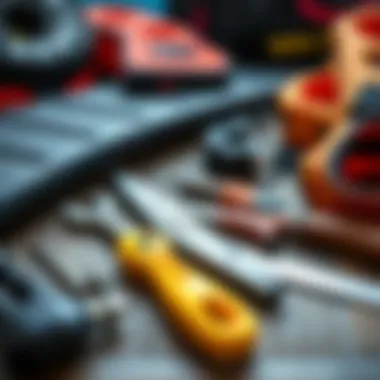
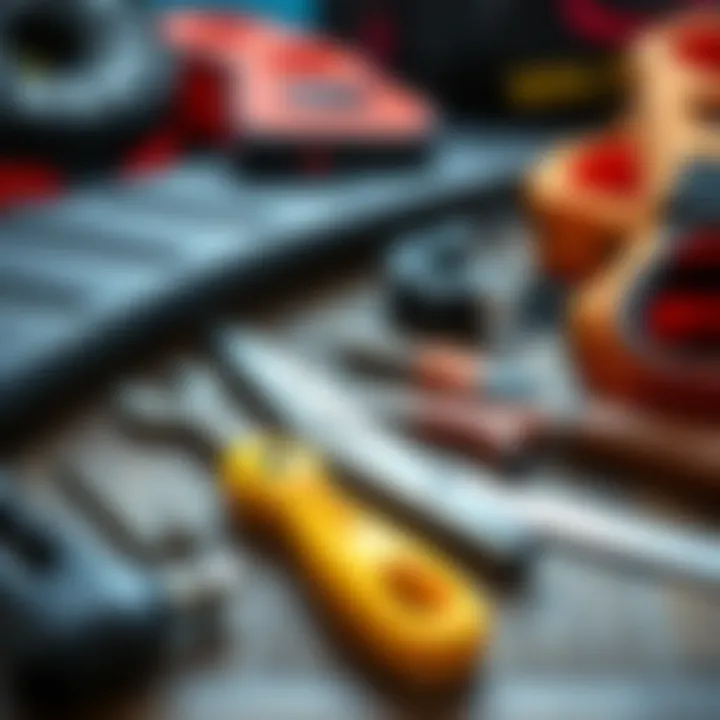
Storing kites the right way is almost an art form. If you toss your kite in a corner after a session, you might be heading for trouble.
- Dry It First: Before storage, always make sure your kite is completely dry. Storing it wet invites mold and mildew, which can seriously damage the fabric and leading edges. This is a straightforward step that can save you from costly repairs.
- Use a Bag: When storing your kites, it's advisable to use a dedicated kite bag. A good bag protects against dust and potential scratches. Ideally, choose a bag with padding. This extra layer of protection can absorb shocks and keep your kite in top shape during transport.
- Avoid Sunlight: If you can, store your kite in a cool and shady spot. The sun's rays can weaken the seams and degrade the material over time, so keep it away from UV exposure as much as possible. Think of it as giving it a cozy, shaded retreat after a long day on the water.
A simple quote to remember: > "An ounce of prevention is worth a pound of cure."
By following these basic storage guidelines, you can glean more years out of your kites and keep them performing at their best.
Essential Considerations for Board Storage
Next up are the boards—one of the more significant investments in your kitesurfing arsenal. Proper storage goes beyond just tossing them on a rack. Here are a few pointers that might save you from future headaches:
- Use a Rack or Vertical Storage: If you can, invest in a rack designed for kiteboards. Keeping them upright or off the floor minimizes the risk of warping, especially if you live in a climate with extreme temperature fluctuations. No one wants a bent board when they’re itching to hit the waves again.
- Clean First: Before you store your board, take a moment to wash off any sand, saltwater, or debris. Changing temperatures can sometimes lead to flaking or damage if dirt is left to sit in crevices. Give your board a gentle scrub and dry it before putting it away.
- Protect the Edges: Consider using edge protectors, particularly if you have a wood or fiberglass board. They can shield those vulnerable corners from dinks and scratches. Think of these little guards as your board’s bodyguards.
In short, investing a little effort in how you store your gear can lead to longer-lasting, better-performing equipment. The right strategies today pave the way for many successful sessions tomorrow.
Budgeting for Kitesurfing Equipment
When diving into the world of kitesurfing, understanding how to budget for equipment is crucial. The right gear can enhance your experience immensely, but an improper financial plan might leave you high and dry—quite literally. Proper budgeting ensures that you can access quality equipment while keeping a handle on your finances, allowing you to fully enjoy the sport without breaking the bank.
Cost Considerations for Beginners
For newcomers to kitesurfing, costs can feel like a tidal wave. It’s not just about the kite alone; a range of items calls for your attention. You'll want to look at the entire setup, which includes the kite, board, harness, and other essential gear. Understanding these costs from the get-go can prevent any nasty surprises.
- Kite Prices: A good kite can cost anywhere from $600 to over $1,500, depending on the type and brand. Beginners might not need the top-of-the-line models, though.
- Board Costs: Expect to spend roughly $400 to $1,200 on a solid board. Choose one that matches your skill level; a beginner board will differ from a pro’s.
- Harnesses and Accessories: Budget around $100 for a decent harness, plus maybe another $50 to $200 for safety equipment like impact vests and helmets.
It’s wise to set aside some funds for future expenditures; this sport requires continual investment in gear to match your growing skill level. Don’t forget about maintenance costs either.
"A penny saved is a penny earned."
Sticking to a budget can keep you from being penny wise and pound foolish.
Investing in High-Quality Gear
Once you’ve assessed what you can afford, consider making a few smart investments in high-quality pieces. Here’s why it matters:
- Durability: Quality gear stands the test of time. You’ll find that better materials often mean a longer lifespan for your kite, board, or harness, reducing the need for constant replacements.
- Performance: Premium gear typically offers superior performance that can make a significant difference in your ride. A well-crafted kite will handle gusts more smoothly, while a high-quality board can improve your maneuverability.
- Resale Value: High-quality equipment also tends to retain its value better. Should you decide to upgrade or switch out gear, a quality brand will fetch a good price on the second-hand market.
It’s often worthwhile to do a little research and read reviews from experienced kiteboarders to identify gear that gives you the best bang for your buck. Investing now could save you hassle and additional costs later.
Embracing kitesurfing without proper financial planning can make the experience more daunting than enjoyable. By paying careful attention to budgeting and prioritizing high-quality gear, you can ensure that your kitesurfing journey takes off smoothly.
Common Gear Misconceptions
When it comes to kitesurfing, there are several misunderstandings that can trip up both novices and experienced riders alike. Knowing the facts can greatly enhance one's enjoyment and safety while flying high above the water. This section delves into common misconceptions surrounding kitesurfing gear, focusing on two main areas: myths about kite sizes and the true costs associated with kitesurfing gear. Understanding these myths is crucial for making informed choices that can affect performance and satisfaction in kitesurfing.
Myths about Kite Sizes
One major myth often circulated among kitesurfers is that bigger is always better. While it might seem intuitive to think that a larger kite can catch more wind and thereby offer greater lift and speed, this isn't necessarily the case. Kite size must be tailored to specific conditions and individual skill levels, and misunderstanding this can lead to difficulties.
Different Environments Call for Different Kites
Consider the following points regarding kite size:
- Wind Speed Variations: A strong wind requires a smaller kite for better control. An oversized kite can quickly become unmanageable in high winds, making it challenging to ride.
- Weight and Skill Level: A lighter rider can use smaller kites effectively. Conversely, heavier riders might excel with larger kites. Understanding your own physique and abilities plays a huge role in the right kite selection.
- Board Type: Trying to match the kite size with the board's characteristics can also influence performance. For instance, a twintip board paired with a medium-sized kite can provide a balanced experience.
Riders must make educated decisions regarding kite sizes based on these factors, rather than relying on blanket statements or anecdotal evidence. Having a range of options helps to cater to differing experiences and conditions.
Understanding Kiteboarding Gear Costs
Another common misconception revolves around the cost associated with kitesurfing gear. Many newcomers tend to believe that high-quality equipment is available only at exorbitant prices. The truth is more nuanced.
Breaking Down the Costs
- Initial Investment: It’s vital to keep in mind that high-quality gear requires an upfront cost, but it often pays for itself over time due to durability and performance. Brands like North Kiteboarding and Cabrinha offer reliable gear that lasts longer than cheaper imitations.
- Maintenance Costs: Owning gear isn’t just about the initial purchase. Regular maintenance expenses, such as repairs or replacement parts, should be factored into the overall budget. A small leak in a kite can snowball into a much bigger problem if left unaddressed.
- Used Equipment: Opting for gently used gear can significantly reduce costs while still offering quality. Be sure to inspect and verify the condition before purchase to avoid unexpected troubles.
"An informed rider is a safer rider."
These misconceptions not only hinder potential growth in kitesurfing skills but can also add unnecessary costs to the experience. By arming oneself with accurate knowledge about the equipment needed, kitesurfers will have the freedom to truly enjoy what the sport has to offer.
For more detailed discussions on gear and safety, you can visit resources like Wikipedia and Reddit.
Future Trends in Kitesurfing Equipment
The world of kitesurfing is ever-evolving, mirroring the advancements in technology and changing user expectations. Understanding these future trends is crucial for enthusiasts at every level, as it directly impacts decision-making when it comes to gear selection. This section highlights key innovations and their implications for both performance and safety in kitesurfing.
Innovations in Kite Design
Innovations play a significant role in shaping modern kite design. Manufacturers are continually experimenting with materials, shapes, and construction techniques to enhance the on-water experience. For instance, new fabrics like ripstop nylon have been used increasingly to create lighter, stronger kites which allow for better control and longevity.
Another trend is the shift toward more versatile kite designs. Kites today are being crafted to provide a balance between speed and stability. Some brands, like North Kiteboarding, have introduced hybrid kites that adapt across various wind conditions, making it easier for riders to switch styles without needing multiple kites.
Moreover, the implementation of aerodynamic designs is a noticeable shift. Kites with refined leading edges and adjustable wing profiles are becoming a norm, providing improved lift and response. This innovation not only enhances user experience but also extends the range of conditions in which the kite can be safely used.
With these technologies, kites are also made more intuitive. For example, developments in integrated control systems have simplified steering and responsiveness, giving beginners a smoother transition into the sport.
"The continuing evolution of kite design aims not only to enhance performance but also to ensure that kitesurfing remains accessible for newcomers, bridging the gap between beginner and expert riders."
Advancements in Safety Gear
As the kitesurfing scene grows, so does the emphasis on safety. New advancements in safety gear reflect this keen awareness. Helmets are now designed with cutting-edge materials like carbon fiber, providing enhanced protection without compromising comfort or weight.
Furthermore, leashes have seen significant upgrades in terms of durability and functionality. They’re being designed to detach or release under certain pressures, minimizing the risk of entanglement, which can be a serious concern in turbulent waters.
Impact vests are becoming a staple, not just for professionals but for everyday users. Several brands have incorporated floatation elements into their impact vests, providing additional safety without the bulkiness of traditional life vests. This dual functionality means kitesurfers can enjoy better buoyancy while also protecting against potential impacts.
Lastly, safety devices such as Quick Release systems are essential in emergencies. Future innovations aim to make these systems easier to trigger, even in high-stress situations, allowing for a quick escape from dangerous scenarios.
End
The conclusion of this guide on kitesurfing gear holds substantial weight, drawing together the myriad threads of equipment insight discussed previously. Understanding the importance of appropriate gear not only amplifies performance but also enhances safety during kitesurfing, an inherently thrilling yet challenging sport.
Summary of Equipment Importance
To truly master the waves, riders must recognize each piece of gear as a vital cog in the kitesurfing machine. From choosing the right kite to assessing board designs, the selection process is nuanced. Just like a chef doesn’t use a dull knife to create a culinary masterpiece, a kitesurfer needs finely-tuned equipment for optimal results. Here are the critical considerations:
- Kite Selection: Different kites cater to various wind conditions and skill levels. Knowing your kite type and size directly impacts your ride quality.
- Board Compatibility: Boards do not only vary in shape but also in performance characteristics, thus making the right match essential for effective maneuvering.
- Harness Fit: A snug, comfortable harness speaks volumes about navigational efficiency on the water.
- Safety Equipment: Prioritizing items like impact vests and helmets is cannot be overlooked.
These pieces of gear either elevate or diminish your experience on the water, highlighting the importance of informed decision-making in equipment purchases.
Encouragement for Informed Purchases
Kitesurfing isn’t just about wielding the wind; it’s about being fully equipped with knowledge. As you dive into choosing your gear, whether you are a seasoned pro or just getting started, here are some pointers to guide you:
- Research Before Buying: Before laying out your hard-earned cash, read reviews from other kitesurfers, compare brands, and consult local instructors. Online platforms like Reddit and kitesurfing forums can be invaluable resources.
- Don’t Rush the Process: Take the time to try different kites and boards before purchase. Many shops offer demo days.
- Consider Long-term Investment: Spending a bit more on high-quality equipment can result in better performance, enhanced durability, and ultimately, cheaper costs in the long run. Your equipment should not just serve you for a season, but for many thrilling rides ahead.
Ultimately, the gear you select reflects your unique style and aspirations within the sport. Equip yourself with knowledge, and you not only enrich your own experience but can help others navigate their kitesurfing journey as well. Your informed decisions can transform an exhilarating pastime into a sport you can enjoy endlessly, embracing both challenge and thrill.
